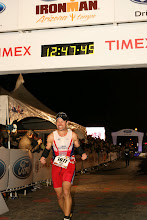Good Morning and Happy Tuesday! Today I have a swim at lunch and a 75 minute run tonight. It will be good to stretch the legs and see how they respond after a tought week of training.
I often talk about fatigue or a tough week or an easy week and I understand that sometimes it is hard to gauge what a tough week is. A tough week for one person is an easy week for another based on fitness, intensity etc... Today is my attempt to explain how Coach Jennifer and I work together to determine the right mix of training, intensity, days off, duration etc... Now a couple of caveats. What I am going to talk about is specific to me and has gotten more accurate over a period of two years of tracking all of my workouts and the periodic "tests" that I have talked about.
So, lets start with the Data. I am only going to talk about my running and cycling because that is the easiest to track. Swimming is much more difficult to collect real data from so the graph I am going to show you excludes swimming. There is just not a good way to track that info right now other than distance and duration. So, when I talk about data, what do I collect:
Run Data includes: Distance (how many miles), Time (how long it took), Pace (how fast I was going), Cadence (how fast my feet were hitting the ground) and route (where did I go)and most importantly Heart Rate (how hard was I working to generate the output of the other data points) and least importantly elevation (was I on a hilly course or flat).
Cycling Data includes: Distance, Time, Speed/Pace, Pedal Cadence, Route, and the most imporatant on the bike is Heart Rate (input) and Power (output).
Let me focus on two items of the above right now. Heart Rate (run and bike) and Power (bike only). Jennifer has me and her other athletes perfrom tests throughout the season that measure and predict key thresholds for Heart Rate and Power. These basically set the standard for each athlete to compare all of their workout to (if that makes sense). To put it another way... Lance Armstrong is going to have different thresholds than I am however, eventhough his are higher and will always be higher we can both work at relatively same intensities when compared to our "standard". He will be exponentially faster but when he is pushing himself as hard as he can climbing The Col Du Tourmalet in France, he is feeling roughly the same way as I would be climbing Pere Marquette. Now he would be able to climb longer etc... but my point is, workouts are relative for each athlete and it all starts with measuring key numbers for Heart Rate and Power. I may try to tackle these in a future blog but not today. I am only beginning to understand them myself.
So, how is all of this data collected. The good news is that I don't have to carry a notebook and pencil with me. The data is all collected automatically. On the run, it consists of a GPS enabled Garmin 405 watch, Heart Rate Monitoing Strap, and a small cadence sensor that is laced in my shoe laces. On the bike, I use a Garmin 705 bike computer, the same heart rate monitor and a pedal cadence sensor on the bike (all very similar to the run). The last piece of equipment is a power meter on the bike. It basically measures how hard or how much power I am putting into the cranks on my bike. Power is key on the bike because speed really means nothing. If I am pedaling into a hurrican force wind and only going 3 miles an hour it will take a lot of Power to move at that 3 miles an hour. If I have the same gale force wind but this time it is at my back, I can apply very little power but travel 25 miles per hour. Power is a great way to measure effort on the bike because it is consistent regardless of environmental factors.
Lastly, once I have all of this data, I use a software program called WKO to see and house all of this data. WKO is the tool that turns the data into something useable. It was originally designed for competitive cyclist but has now incorporated running and cycling (and other sports for that matter) to help analyse performance.
Now that I have all of the basics out of the way, my next blog will talk about perfromance management and how Coach Jennifer at Tri Smart uses the data and turns it into something meaningful that I can train by.
So just to summarize, here is what you need to know: Everything I do I measure. Testing helps determine how hard I am working (or not on lazy days) of each workout compared to my capabilities. My next blog tomorrow will talk specifically how this has helped me.
As a house keeping note: I know this blog is nearly impossible to subscribe to and I apologize, very short sited on my part. If you ever want to give me feedback please send me an email to tbulterATacropolistech.com. If have replaced that @ sign with AT so I don't get spammed too bad. I know people are reading the site, I just don't know who and feedback is greatly appreciated.
All for now
Tracy
Tuesday, September 14, 2010
Subscribe to:
Post Comments (Atom)






No comments:
Post a Comment